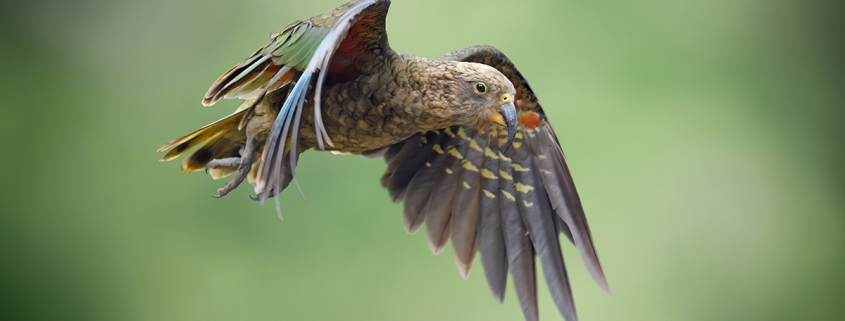Please help save the kea from poisoning and harassment
Playing with these big parrots, in car parks and at ski fields, is one of the best experiences NZ has to offer animal lovers. But the kea’s home, the alpine herb fields and rainforests of southern NZ, is being poisoned by the New Zealand Government.
Sign the Petition help save the Kea
Below are quotes from Scientists, the Government and others about the fate of the world’s only mountain parrot
The Kea, the world’s only mountain parrot, needs your help!
“View the “Kea References” to read quotes from scientists, DoC and lay people to find out more about the threats to kea”
“In the South Island, 23 pest control operations, covering approximately 700,000 ha of beech forest, are planned for the coming late winter and spring” – National Pest Control Agencies 2014
Cinnamon-flavoured, cereal food pellets will be spread from the air, twice. The first time they will be just flavoured cereal. The second time, they will contain deadly 1080 poison.
Kea will eat the cereal baits and die. They will also be poisoned if they drink from ponds and alpine tarns where the baits lie, or scavenge poisoned carcasses or eat the dying insects surrounding the poisonous baits.
It was first recognised that the government’s poisonings were killing kea in 1963.
In 2008, government monitoring of the kea began.
The monitoring showed that large numbers of kea were dying.
“A total of 150 kea were monitored and 20 keas deaths resulted from consuming 1080…It is also possible that kea deaths were not detected at the other sites due to small sample size.”
– DOC Code of Practice for Aerial 1080 in Kea Habitat, 2014
At one site (North Okarito) 77% of the monitored kea died.
1080 poisoning is very cruel. It causes extreme spasms and vomiting, with suffering for many hours or days.
In 2014, the poisoned baits are to be spread
-
- • In midwinter (before 31st Aug), when the birds are hungry, and
- • further up the mountains into the alpine herb and tussock fields
“The ‘performance standards to reduce kea deaths’ no longer include a standard to avoid sowing open areas above the tree line… We are planning to sow 0.15% 1080 Pellets in some open alpine areas to protect rock wren” – DOC Code of Practice for Aerial 1080 in Kea Habitat, 2014
No bird repellent will be used. No repellent has been successful so far.
Many kea are likely to die.
There are not many kea left.
In 1986 and 1992, it was estimated there were 1000-5000 kea, in total.
Quotes since then show that numbers have declined markedly:
“the population in the Nelson Lakes National Park area has plummeted 80 per cent over the last 10 years.”
– T. Orr-Walker, Kea Conservation Trust Updates, 2012
“I did however spend many days up at Coronet Peak and the Remarkables and saw very few kea…Bit of a sorry state of affairs.” – G. Glass, Kea Conservation Trust Updates, 2011
“They are an integral part of the mountain scene here, and I have definitely noticed a considerable lack of sightings in the last ten years…”
“…let the general public know that we have a real problem with the number of keas left in the wild- a fact that most people are unaware of as these keas that are out there always seem to be in your face so to speak.”
– M. Curtis, Cardrona, Nestor Notabilis 6, 2012
“Given the birds’ relatively high extinction risk, continued killing of kea is unjustifiable”
– G. Elliot & J. Kemp, NZ Dept of Conservation Internal Science Series 181, 2004”
Kea endure many other hardships, including starvation:
“In winter, green droppings of bile indicate that many juvenile Keas are starving”
– J. Jackson, Notornis, 1960
“A bad season, as 1957-58 summer, can greatly reduce the number of Keas”
– J. Jackson, Notornis, 1969
The Government poisonings will not only kill off precious kea.
There is solid evidence that the Government’s 1080 poisonings kill many other native creatures and cause plagues of unwanted species. The whole ecology is at stake.
“ship rat abundance indices increased nearly fivefold after possum control and remained high for up to 6 years…
….the typical outcome for most pulsed possum control is an uncontrolled ship rat population”
– P. Sweeetapple & G. Nugent, NZ J. Ecology, 2007
“mice are so far the Achilles heel of many programmes, with mouse numbers irrupting”
– D. Armstrong et al., NZ J. Ecology 2010
“The reduction in rats, the main prey of stoats, may lead to an increase in stoat predations on birds…”
– DoC Operational Report, Otira 2011
“stoats are likely to have the greatest effect on birds after successful 1080 poison operations”
– E. Murphy et al., NZ J. Ecology, 1998


